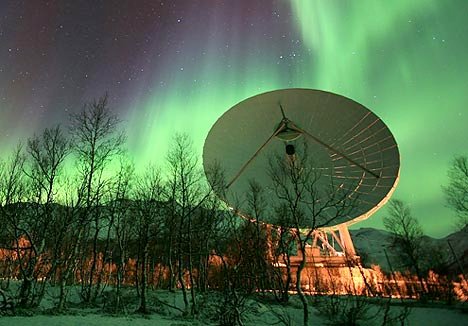Have Super Aliens Already Left Our Visible Universe? A Closer Look At The Transcension Hypothesis
Ellen Lloyd – MessageToEagle.com – We have previously discussed the possibility that super aliens may already live inside supermassive black holes, a theory that was put forward by Russian cosmologist Vyacheslav I. Dokuchaev.
This brings us to another interesting question dealing with the likelihood that highly advanced alien civilizations might have left our Universe into what may be called “inner space”, a subject that scientists refer to as the Transcension Hypothesis proposed by John Smart.
This is an attempt to explain what happens after the technological singularity as well as a possible solution to the Fermi paradox.
Futurist John Smart, and other scientists have suggested that evolution and development may work the same way in the universe as a system. Our Universe could be engaged in a life cycle (“Big Bang” birth, growth, maturity, replication, senescence, and eventual thermodynamic or other death).
This brings us to the possibility that our Universe could have a twin. If universal change is analogous to the evolutionary development of two genetically identical twins, two parametrically identical universes (possessing identical fundamental physical parameters at the Big Bang) would exhibit unpredictably separate and unique internal evolutionary variation over their lifespan (unpredictable differences in specific types of species, technologies, and knowledge among civilizations), and at the same time, a broad set of predictable and irreversible developmental milestones and shared structure and function between them (broad and deep commonalities in the developmental processes, body plans, and archetypes of life, culture, and technology among all intelligent civilizations).
See also:
Extraterrestrials Are Waiting For The Right Moment Before They Make Contact – Scientists Say
Are Extraterrestrials Capable Of Altering Our Reality?
More About Extraterrestrial Life
This question is thus relevant to astrophysics, astrobiology, and astrosociology. It is one potential developmental process that, if validated, would have a great impact on the future of civilizations.
The transcension hypothesis should not be confused with the expansion hypothesis. “The expansion hypothesis (Kardashev 1964, and many others since) predicts that some fraction of advanced civilizations in our galaxy and universe must become beacon builders and spacefarers, spreading their knowledge and culture far and wide.
Expansion is the standard expectation of those engaged in SETI (search for extraterrestrial intelligence) and METI (messaging to extraterrestrial intelligence) today.
Expansion scenarios typically assume ETI messaging to be bounded by the speed of light, and space travel to occur at some significant fraction of the speed of light.
By contrast, the transcension hypothesis, also known as the developmental singularity hypothesis (Smart 2000, 2008, 2010) proposes that a universal process of evolutionary development guides all sufficiently advanced civilizations increasingly into inner space, the domain of very small scales of space, time, energy and matter (STEM), and eventually, to a black-hole-like destination, censored from our observation, “John Smart writes in his paper, “The Transcension Hypothesis: Sufficiently Advanced Civilizations May Invariably Leave Our Universe, and Implications for METI and SETI.”
Even though proving the existence and exclusivity of the transcension hypothesis with today’s science may be impossible, we cannot dismiss the possibility that highly advanced alien civilizations could leave in the unobservable Universe.
Smart also says: “If all universal intelligence eventually transcends to black-hole-like environments, after which some form of merger and selection occurs, and if two-way messaging (a send-receive cycle) is severely limited by the great distances between neighboring and rapidly transcending civilizations, then sending one-way METI or probes prior to transcension becomes the only real communication option.
But one-way messaging or probes may provably reduce the evolutionary diversity in all civilizations receiving the message, as they would then arrive at their local transcensions in a much more homogenous fashion.
Is there a prime directive prohibiting one-way messaging? Image: The EISCAT Space Centre in Svalbard, Norway
If true, an ethical injunction against one-way messaging or probes might emerge in the morality and sustainability systems of all sufficiently advanced civilizations, an argument known as the Zoo hypothesis in Fermi paradox literature, if all higher intelligences are subject to an evolutionary attractor to maximize their local diversity, and a developmental attractor to merge and advance universal intelligence.
In any such environment, the evolutionary value of sending any interstellar message or probe may simply not be worth the cost, if transcension is an inevitable, accelerative, and testable developmental process, one that eventually will be discovered and quantitatively described by future physics.
Smart also suggests there might be a prime directive that blocks all one-way messaging by advanced civilizations.
“If the closest receiving civilization for a METI (message to extraterrestrial intelligence) beacon is on average 100 light years away, by the time any technology-using civilization can send a message, their local evolution will be proceeding so fast that the send-receive cycle (200 years) will be far too long to aid in local evolutionary complexity construction.
See also:
Advanced Alien Civilizations Could Live In Globular Star Clusters
Invisible Aliens: Extraterrestrial Life May Be Beyond Human Understanding
In other words, the special self-organization of our universe, with its speed of light limit and the great gulf between intelligent civilizations allows only developmental messages over interstellar distances. Such one-way messages are useful only for control and constraint, not for innovation or complexity construction. The vast light-distances between civilizations, their continuous local acceleration via STEM compression, and the curious time-travel properties of black holes together suggest the great unlikelihood of any civilization communicating through normal “slowspace”on their way to their respective transcensions.
For example, assume that we immediately discover evidence of life on a planet 100 light years distant.
If it takes an average of 600 years for each civilization to be able to enter a local black hole, we could conduct a maximum of three two-way information exchanges before one of us transcended. Due to this severe two-way messaging limit in normal space, such communication would be a very rare, very local, and short-lived phenomenon.
We may then be able to prove, using information theory, that sending one-way METI or probes containing simple information (already known to the sender) is not worth the cost to send, and sending advanced information or probes will only reduce the evolutionary diversity in all civilizations receiving and implementing the message.

Consider the likelihood that any advanced information we sent to other civilizations would just push them into their black hole transcension in a more clonal way, and we’d meet significantly less-interesting and useful “copies of ourselves” in our later merger, a fate we might seek to avoid by all reasonable means.
A type of “Prime Directive” against one-way non-local messaging would seem likely to be a moral development emerging in all sufficiently advanced civilizations, once they recognize that they are on course to a black hole destiny.
A variation of this idea in the Fermi paradox literature is called the zoo hypothesis (Ball 1973), the idea that advanced civilizations avoid contact with less advanced civilizations so that they do not influence their evolutionary development. The transcension hypothesis is thus a specific variant of the zoo hypothesis.”
Our quest for advanced alien civilizations takes us to the most remarkable places, even the invisible world…
Written by Ellen Lloyd – MessageToEagle.com
Copyright © MessageToEagle.com All rights reserved. This material may not be published, broadcast, rewritten or redistributed in whole or part without the express written permission of MessageToEagle.com
Related Posts
-
 Fantastic Biological Street Lighting: Using Glowing Plants And Trees As An Energy Source
No Comments | Jun 2, 2016
Fantastic Biological Street Lighting: Using Glowing Plants And Trees As An Energy Source
No Comments | Jun 2, 2016 -
 Legendary Beowulf Fighting Dragon Grendel In Heroic Poem Written In Anglo-Saxon England
No Comments | Aug 16, 2022
Legendary Beowulf Fighting Dragon Grendel In Heroic Poem Written In Anglo-Saxon England
No Comments | Aug 16, 2022 -
 What Happened To The Mysterious And Beautiful Queen Nefertiti?
No Comments | Apr 4, 2017
What Happened To The Mysterious And Beautiful Queen Nefertiti?
No Comments | Apr 4, 2017 -
 Can Parallel Universes Explain The Déjà Vu Phenomenon?
No Comments | Jan 22, 2015
Can Parallel Universes Explain The Déjà Vu Phenomenon?
No Comments | Jan 22, 2015 -
 Master Kong Confucius: Great Philosopher And ‘Teacher Of All Teachers’ Ahead Of His Time
No Comments | Dec 30, 2016
Master Kong Confucius: Great Philosopher And ‘Teacher Of All Teachers’ Ahead Of His Time
No Comments | Dec 30, 2016 -
 Legend Of The Candle Dragon That Could Lighten The Darkest Gate Of Heaven
No Comments | Jan 15, 2016
Legend Of The Candle Dragon That Could Lighten The Darkest Gate Of Heaven
No Comments | Jan 15, 2016 -
 Pharaoh Hatshepsut: Skillful And Efficient Female Ruler Who Brought Prosperity To Ancient Egypt
No Comments | Mar 22, 2017
Pharaoh Hatshepsut: Skillful And Efficient Female Ruler Who Brought Prosperity To Ancient Egypt
No Comments | Mar 22, 2017 -
 Book That ‘Killed’ – Are Written Or Spoken Words Powerful Enough To Take Control Over Our Actions?
No Comments | Oct 21, 2015
Book That ‘Killed’ – Are Written Or Spoken Words Powerful Enough To Take Control Over Our Actions?
No Comments | Oct 21, 2015 -
 Medieval Criminals Could Avoid Persecution By Claiming Sanctuary In Churches
No Comments | Mar 3, 2017
Medieval Criminals Could Avoid Persecution By Claiming Sanctuary In Churches
No Comments | Mar 3, 2017 -
 This Native American Chief Risked All To Give Us The Prophecies And Knowledge Of The Star People—The Story Of How Standing Elk Became Chief Golden Light Eagle
No Comments | Apr 27, 2017
This Native American Chief Risked All To Give Us The Prophecies And Knowledge Of The Star People—The Story Of How Standing Elk Became Chief Golden Light Eagle
No Comments | Apr 27, 2017

